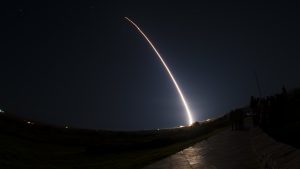At the same time that the bilateral legal regime on missiles is crumbling, more states are acquiring missiles, for more reasons. More states in Asia than in any other region have deployed or flight-tested ballistic missiles capable of reaching intercontinental ranges. The increasing interest in hypersonic weapons may create new demand for medium and intermediate-range missiles. Shorter-range ballistic missiles continue to be actively acquired, both as nuclear-weapon delivery systems and as conventionally armed strike weapons.
Chief among the changes in recent decades is the development of new missile technologies. The prevailing absence of constraints has enabled and even driven governments to counter the defenses of other countries by developing maneuverable re-entry vehicles, jamming devices, advanced cruise missiles and hypersonic weapons.
The implications of new missile technologies extend beyond strategic competition between states, however, they also endanger international stability and civilian life.
Advances in guidance technology, for example, mean that ballistic missiles are increasingly being used in conflict, including by non-state actors. By making missiles easier to use, these innovations have also contributed to tragedy off the battlefield, including the downing of two civilian airliners in recent years.
Another concerning shift involves the production of longer-range artillery rockets that are hard to distinguish from nuclear-capable ballistic missiles. This blurring of categories has the potential to erode the utility of existing arrangements on missiles, such as the stricter export controls applied to certain missiles in the Missile Technology Control Regime (MTCR).
Changes like these pose a significant challenge in efforts to design effective controls. While agreement to extend the 2010 Strategic Arms Reduction Treaty (New START) before it expires in February 2021 would be a positive step, that bilateral treaty cannot alone provide adequate protection. Existing multilateral arrangements, such as the MTCR and Hague Code of Conduct Against Ballistic Missile Proliferation, are non-binding and far from universal. Many missile-producing and exporting countries in Asia are not members of any of these arrangements.
The UN General Assembly has tried before to take a sweeping, comprehensive approach to the security implications of missiles, but targeting particular areas with different responses may be the most feasible way forward.
There are several avenues for governments to tackle missile threats through modern, tailored approaches. Here are five that deserve exploration.
First, we should look for ways to progressively bring more governments into efforts to develop missile controls. One way to start may be to take a fresh look at how we can preserve and work towards the historical objective of eliminating nuclear-weapon delivery systems alongside nuclear weapons themselves. While countries with the largest arsenals still have a responsibility to lead and continue reductions, more states need to be brought into the process. The 191 state parties of the 1970 Treaty on the Non-Proliferation of Nuclear Weapons have committed to this aim, and pursuing it fully could entail a broader reckoning with missiles that may be nuclear-capable.
Second, we need to establish checks on destabilizing new missile technologies. There is significant uncertainty about how states deploying hypersonic glide vehicles will arm them since they would be nuclear-capable, but may also be effective with conventional payloads. The relatively nascent state of this technology, however, provides a potential opening. Governments should proactively seek to define and address the risks associated with hypersonic weapons, particularly given the current international security environment characterized by mistrust and lack of dialogue. At a bare minimum, states developing and deploying these weapons should share more information about their nature and role to reduce risks of misunderstanding and miscalculation.
Anti-satellite missiles are another destabilizing technology, and I am hopeful that governments can effectively address this threat in ongoing talks on outer space security. If states can agree on a response to those systems, I believe they also could productively engage on the complexities that missile defenses have introduced in recent decades.
Third, we need to ensure that governments apply current transparency mechanisms and norms to all missiles that can harm civilians. Most surface-to-air missile systems remain outside even voluntary transparency measures. As these missiles become more widely available, including possibly to non-state armed groups, we should consider bringing the systems into the same frameworks for transparency and accountability that apply to most other heavy conventional weapons.
Fourth, we need to work on a set of common, agreed definitions. Countries regularly lock horns at the UN over rarefied concerns like the distinction between artillery rockets and ballistic missiles, making it clear that a systematic and widely understood taxonomy of missiles could help governments identify particularly destabilizing or harmful types of weapons and, ultimately, means for their control.
Fifth, regional approaches are also worth exploring. Only a few countries in the world’s five declared nuclear-weapon-free zones possess missiles considered capable of delivering nuclear weapons, suggesting there may be unexplored potential for states in the zones to build new norms. Governments should also consider how missile controls may fit into any future arrangements for regional security and disarmament.
Preventing the spread and emergence of destabilizing missile threats is a vital, unfinished task for the international community. By approaching it in these five ways, we can continue making progress in an area critical to preserving global peace, security and stability.
Izumi Nakamitsu is UN under-secretary-general and high representative for disarmament affairs.

































